Silver dollar fish are becoming more popular as aquarists discover their many charms. Besides being stunning to look at, they are a great schooling fish for larger fish tanks. Silver dollars are also hardy once established and look enough like their cousins the piranha to make good conversation pieces for visitors! What else is there to discover about silver dollar fish care?
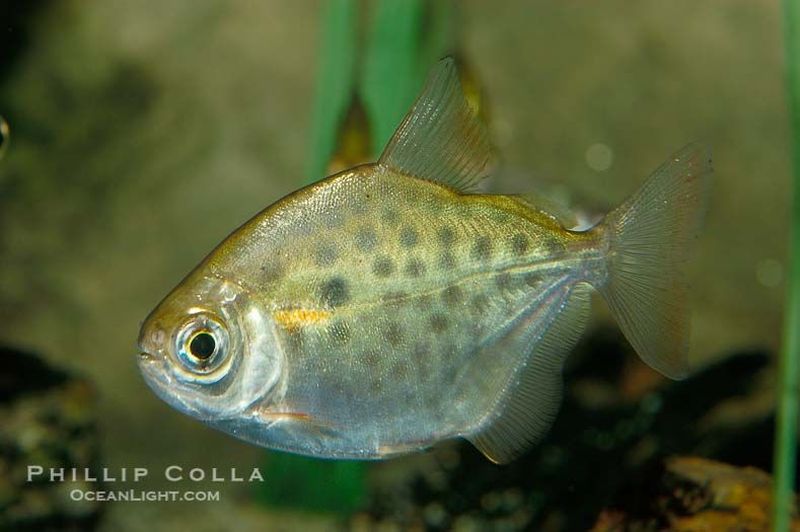
Getting to Know the Silver Dollar Fish
Silver dollar fish are some of my favorite aquarium fish to talk about because they are far more interesting than you might think! For one, they are incredibly beautiful, with brilliant silver scales and a round profile that make it easy to see how they get their name.
Peaceful to the point of being shy, silver dollar fish are a good addition to the majority of community tanks. But believe it or not, they are actually very close relatives of the fearsome piranhas! You can see the resemblance in the tiny scales, red coloration, and facial structure.
The difference is that silver dollar fish are entirely vegetarian while piranhas are mostly or entirely carnivorous. But both fish have massive sets of teeth, which we will explore in greater detail below!
Silver dollar fish, pacus, and piranhas are grouped in the subfamily Serrasalminae, which is under the main family Characidae. This makes them all closely related to the much tinier tetra fish; including neon tetras and other aquarium favorites! Again, with a close look, you can see the resemblance. Tetras also have the same tiny scales, a fatty adipose fin between the dorsal and tail fin, and are toothy predators of worms and other tiny prey!
A full-size silver dollar fish will be anywhere from 4 to 7 inches long as it depends entirely on the species you have. Each of the five main species we are covering here will reach at least 5 inches and need to be kept in good sized groups. So you will need an aquarium no smaller than 55 gallons in volume once they have grown up.
Besides their space needs, silver dollars are not especially hard to take care of. They are very enjoyable to watch and will be long-lived aquarium residents of medium to large community tanks!
- Scientific Name: Metynnis, Myleus, Myloplus, Mylossoma sp., subfamily Serrasalminae, family Characidae
- Origin: Amazon basin, South America
- Length: 6 to 12 inches
- Aquarium Size: 55+ gallons
- Temperament: Peaceful; Schooling
- Ease of Care: Easy
Types of Silver Dollar Fish
When looking for silver dollar fish for sale, you will come across quite a few different species! There are four genera and dozens of species out there. But these are the five species that are by far the most common types of silver dollar fish to find in pet stores!
Common Silver Dollar Fish
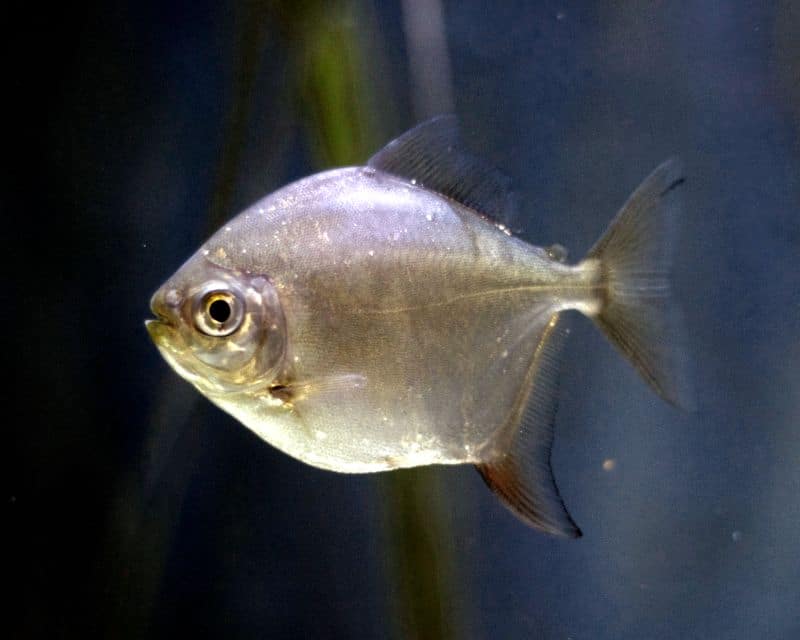
As the name suggests, the common silver dollar fish (Metynnis argenteus) is the one you will see most often in pet stores. It is almost entirely a vibrant silver color, with no spots, stripes, or bars. Common silver dollars are also a larger species, regularly reaching 6 to 8 inches in length when fully grown.
Spotted Silver Dollar Fish
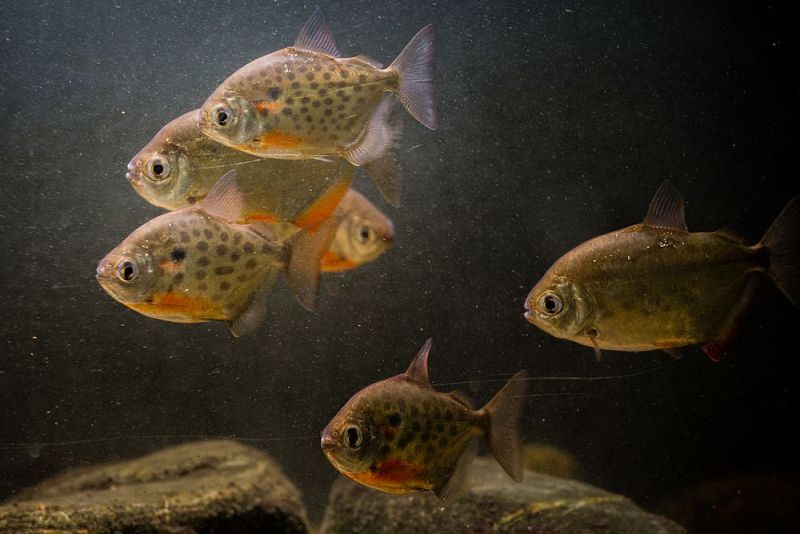
The spotted silver dollar fish (Metynnis lippincottianus) is a little more uncommon but well worth snatching up if you find them for sale! While it is also primarily bright silver green tones along the upper half of the fish and liver-colored spots along the flanks gives it some color diversity. Spotted silver dollar fish even have a bit of red along the anal fin. They usually reach 5 to 6 inches long as full grown silver dollar fish!
Red Hook Silver Dollar Fish
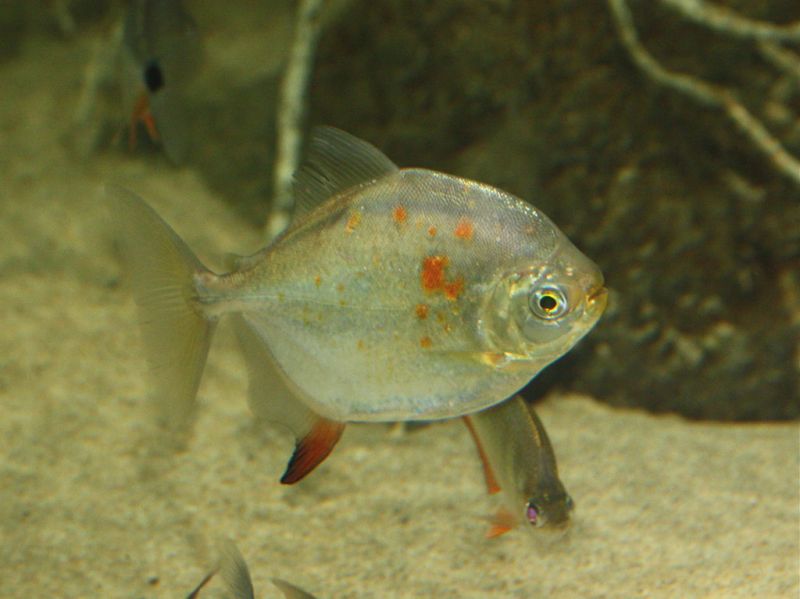
The red hook silver dollar fish (Myloplus rubripinnis) is possibly the most sought after type of silver dollar fish. Not only is it a vibrant silver but it also has a distinctive curved red anal fin that has a strong hook shape to it. They also have scattered patches of color that range from yellow to bright red along their flanks. Keep in mind that these are one of the largest of the commonly available species; growing 8 to 10 inches long!
Tiger Silver Dollar Fish
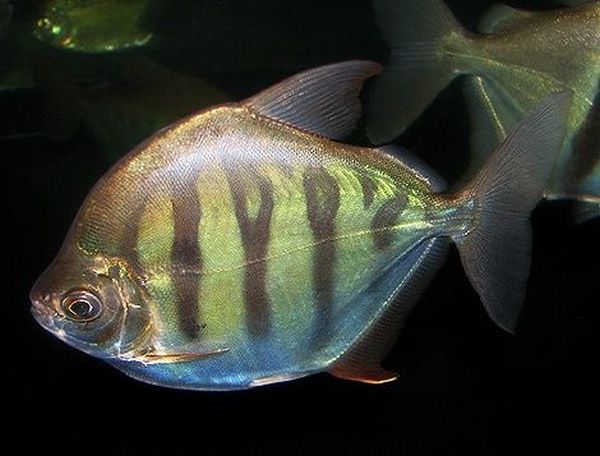
Another species to discover is the tiger silver dollar (Metynnis fasciatus), a type that has only recently entered the trade. It is easy to see how Tiger silver dollar fish get their name: the dark stripes against the gold and green background. They have the smallest amount of silver compared to the others on this list. Tiger silver dollars are also a smaller species, rarely growing beyond 5 inches in length.
Black Bar Silver Dollar Fish
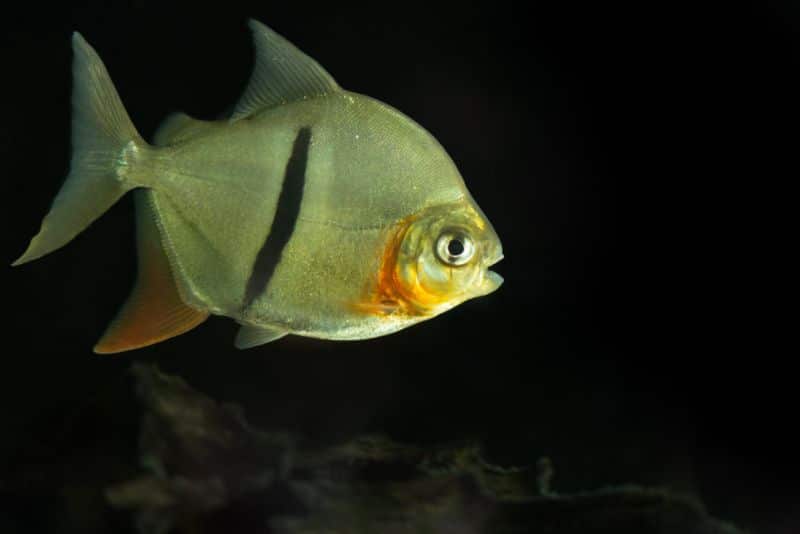
Last comes the black bar silver dollar fish (Myleus schomburgkii), a medium sized type of silver dollar fish that reaches 5 to 8 inches long when fully grown. They are a little rarer and as much in demand as the red hook silver dollar! It not only has a smaller red hook-like anal fin but a distinctive black bar along its side. The black bar silver dollar fish is also not as long as the red hook, making it a good match for aquariums as small as 75 gallons in volume!
Silver Dollar Fish Care
While they are fast, flighty, and not too small, silver dollar fish aren’t too complicated to care for. They are also peaceful and eager eaters of anything green!
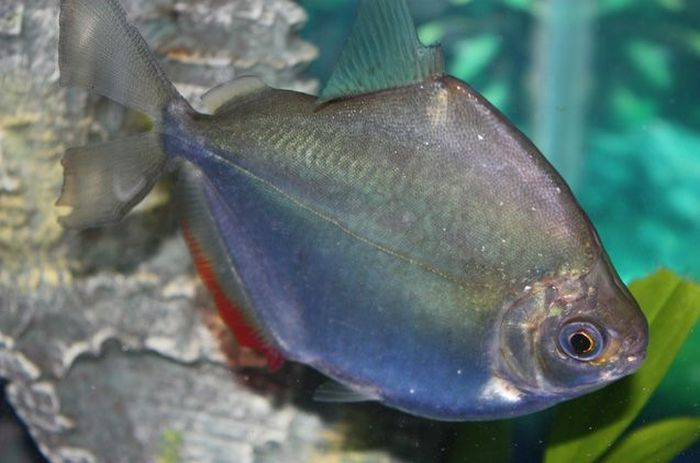
Silver Dollar Fish Size and Aquarium Needs
Silver dollar fish size means that they need more spacious aquariums than many common community fish. They are also extremely active and are shy to the point of being skittish at times.
Turning on the lights suddenly, aggressive tank mates, or swift motions can cause the entire school to rush off in a random direction. These flights can result in them bashing against decoration and aquarium glass, causing injury.
So a minimum aquarium for a group of silver dollar fish is 55 gallons. That said, 75 gallon aquariums are even better due to the extra 6 inches of width they provide!

How Big Do Silver Dollar Fish Get?
Silver dollars are solidly in the category of medium sized aquarium fish. A small silver dollar might only be 4 inches long. But the majority will reach 5 to 8 inches in size as a full grown silver dollar fish.
How Long Do Silver Dollar Fish Live?
Silver dollars, piranhas, and pacus are all very long-lived fish. You can expect a young silver dollar fish to live for 10 to 15 years if well cared for! This means a spacious aquarium, clean water, a varied diet, and plenty of their own kind to socialize with!
Silver Dollar Fish Water Parameters
Like most fish from the Amazon River basin and its tributaries, silver dollar fish need soft, alkaline water to do well. While they are sometimes captive bred the vast majority are wild caught fish so they won’t adapt too well to hard, alkaline water.
The pH should be between 5.0 and 7.0 and hardness should be moderate to low. One way to decrease the alkalinity without using purely R.O. or distilled water is to include driftwood or indian almond leaves. Both of these additions contain plant based tannic acids, which help buffer the pH towards acidity!
Silver dollar fish are also a little more sensitive to ammonia, nitrite, and nitrates than many other aquarium fish. Likely again because the majority are fresh from the wild, where these pollutants simply don’t have a chance to build up. So only add silver dollar fish to mature, well established aquariums!
Silver Dollar Fish and Plants
One of the hardest parts to keeping silver dollar fish is their love affair for anything green and growing. They are purely vegetarian and have the teeth to prove it. But they take eating plants to new extremes: there really aren’t any aquatic plants that are safe to keep alongside silver dollar fish.
Even some of the plant species that most fish find distasteful, such as Anubias or Java Fern, are often still on the menu for silver dollars. These plants have tough, bitter leaves but that still won’t stop them from nibbling these slow growing plants down to nothing.
If you insist on trying to keep Silver Dollars alongside plants your only chance is to feed them huge amounts of fresh greens. Otherwise any live plants will just be treated like a salad bar.
Ich on Silver Dollar Fish
Unfortunately, silver dollar fish are very prone to catching the ich parasite (ichthyosporidium). Ich is actually something that all tetra fish and their relatives are susceptible to because they tend to be a little more sensitive to poor water quality than other aquarium fish.
Their very fine scales are also easily penetrated by aquatic parasites like ich. So if you see ich on one of your silver dollars, try to isolate it in a quarantine tank for treatment as soon as possible before the spots burst, releasing more parasites into the water. Otherwise you will have a full-scale ich infection of all of your silver dollar fish in very short order.
Fine scaled and scaleless fish need to be handled very delicately when ich is concerned. Since they don’t have as much of a barrier between the water and their bodies they can soak up more medication than is recommended. Overmedicating these fish can sometimes be fatal, as a result.
Since silver dollar fish do have scales, simply follow the dosing instructions to the letter. I also recommend keeping the temperature above 80℉, which speeds up the life cycle of the parasite.
Ich is rarely fatal in previously healthy fish kept in clean conditions. But it is debilitating and irritating to your pets. And even a previously infected fish can catch it again and again; it’s not like the flu. So take it seriously and isolate any fish with the first signs of ich (white growths that are about the size of salt grains scattered on the skin and fins).

Feeding Silver Dollar Fish
Silver dollar fish may be a little sensitive to ich and poor water quality. But they are some of the easiest fish to feed because they have very hearty appetites!
Just be aware that silver dollar fish are entirely vegetarian by nature. So you should be feeding them a mixture of raw greens and prepared pellets that use a plant-based formula. These days it is easy to find blends that use spirulina, spinach, chlorella, and other algae and plant-based foods.
You can supplement these with vegetables clipped into place and held underwater. For many fish you want to lightly boil terrestrial vegetables to make them softer and more palatable.
But the powerful teeth of silver dollars let them munch zucchini, squash, spinach, lettuce, and other plants with ease. I also recommend buying bunches of cheap, soft aquatic plants like cabomba and anacharis occasionally!
Pieces of Japanese nori soaked in water are also very nutritious and will be devoured in seconds by these vegetarian piranhas!
Silver Dollar Fish Teeth
Like their close relatives the piranha and pacu, silver dollar fish have impressively large teeth for their size. In fact, if you ever get to see them free of the gums, they look disturbingly similar to human teeth. Since we also evolved from vegetarian stock, it makes sense; it just feels eerie seeing such similar teeth in a fish!
Tank Mates for Silver Dollar Fish
While silver dollar fish are quite peaceful, you do need to have some caution in choosing tank mates for them because they can be extremely skittish. Other fish that are extremely active, aggressive, or territorial can cause them severe stress if the tank is too small.
Silver dollar fish are popular dither fish for large species community tanks. They can provide a sense of activity and safety for cichlids and other large loners. But if the aquarium does not give the silver dollars enough room to avoid their turf, a sudden spat can cause the silver dollar fish to try and leave, violently.
They are prone to dashing frantically in any direction, often losing scales from colliding with decorations like rocks and driftwood. They may even try leaping from the tank, which they may succeed at even if you have a lid since they are not small fish. So choose tank mates that won’t give them too much trouble.
Cichlids, even predatory types, can work so long as they are not too aggressive. With how wide-bodied and hard to swallow silver dollar fish are they will usually be ignored by other predators like arowanas. Large catfish, pacus, other characins, eels, and stingrays also make great companions for them!
Good Tank Mates for Silver Dollar Fish:
- Peaceful to Semi-Aggressive Cichlids
- Gouramis
- Large Catfish
- Eels, Stingrays, and other Bottom Dwellers
How Many Silver Dollar Fish Should I Have?
While silver dollar fish get along with most fish their own size or smaller, there is no question that the best tank mates for silver dollars are their own kind. In the wild, they form schools of dozens to hundreds of individuals, just like tetras and other characins. So the more you buy, the safer they feel.
The only problem is that these are not small fish! So make sure that you are willing to buy an aquarium large enough to comfortably house so many large, schooling fish! Six is an absolute minimum for a group of silver dollar fish, with more always being better!
Breeding Silver Dollar Fish
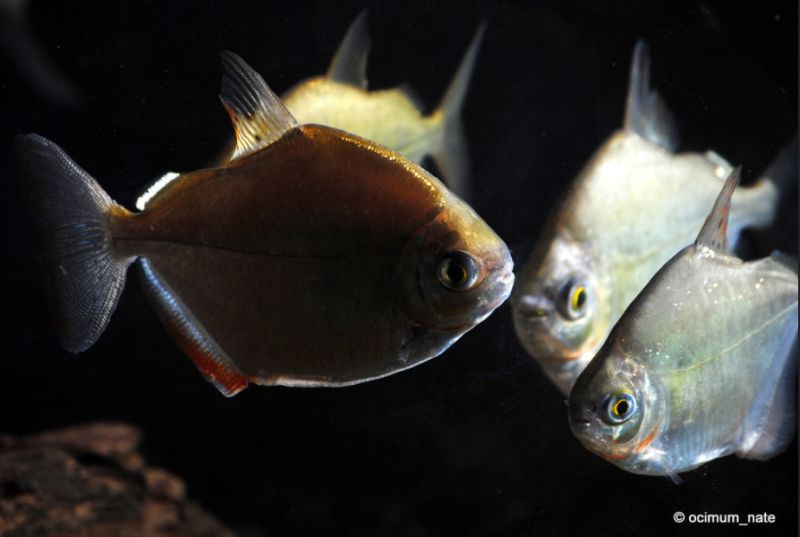
Breeding silver dollar fish is an immense challenge due to their need for company and space but it is not impossible. They are an odd mixture of group and pair-based spawners, forming loose harems where males and females trade partners in the wild.
In home aquariums they tend to form pair bonds but not often for life, as cichlids and many other fish tend to do. Since silver dollar fish are not sexually dimorphic, you won’t be able to tell males from females apart just by looking.
But so long as you’ve fed and cared for them well, eventually the females may swell visibly with eggs. You may also be able to discern sexes by behavior: males will almost always chase after gravid females if the mood is right.
Silver dollar fish are egg scatterers so once they embrace and fertilize their eggs in the water column they leave the eggs and fry to fend for themselves. The young hatch in days and immediately begin feeding on infusoria and other planktonic sources of food.
As they grow larger and grow bigger teeth they transition over to vegetables and become recognizably fish shaped!
More Frequently Asked Questions about Silver Dollar Fish
No, in fact silver dollar fish are peaceful to the point of being extremely shy and skittish. They should be kept away from aggressive fish since they will dash or leap in fear, which can cause injury or death.
Ideally, you should always have at least six silver dollar fish so they can form a school and feel more secure. Anything less and they will be even more easily frightened than usual. If you have space for more than six then it is a good idea to add more of them!
Pretty much any fish that is not too aggressive will make good companions for silver dollar fish. While they aren’t small they are not predatory and won’t molest guppies, tetras, and other small fish. Silver dollars also aren’t fin nippers so they won’t bother slower, peaceful tank mates.
Silver dollars are very friendly and ideal community tank residents for medium to large sized aquariums!

